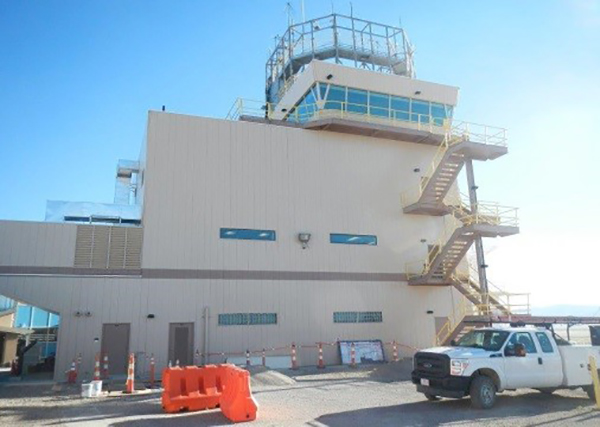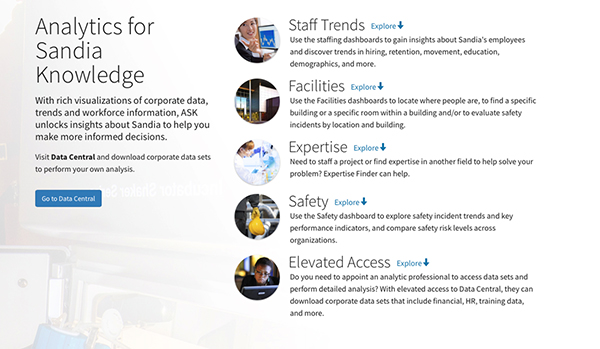Key infrastructure projects completed

Facilities Management and Operations Center (FMOC) executed three key infrastructure projects funded by NA-50. In partnership with multiple centers within Division 2000 and Center 1200, FMOC coordinated and completed work on the Tonopah Test Range Control Tower, the Explosives Component Facility addition, and multiple refurbishment efforts for the Neutron Generator Production Facility. (4800)

Analytics for Sandia Knowledge
The Analytics for Sandia Knowledge (ASK) suite of tools was delivered and put into full production in FY16. ASK enables the enterprise to leverage corporate data in new and innovative ways. The suite of capabilities includes the framework, toolsets, and access to a collection of 46 enterprise data sets, allowing Sandia management and data scientists to run custom reports and analytics against the data. In addition, a set of general-use analytics and visualizations has been made available to assist the enterprise. The suite of tools can be accessed by managers at ask.sandia.gov. (9500)
ERPlus transformed the work experience by successfully integrating the Expense Report and Event Tracker applications. Several system enhancements and policy changes for the user were implemented through ERPlus, including the creation of an expense report from a conference request, automatic expense report approvals (where no exceptions exist), per diem costs for meals and incidentals auto-populated based on destination, lodging costs verified using Federal Travel Regulations, and paperless receipt documentation for all expense reports, which will eliminate hundreds of boxes per year of Corporate Storage as users choose this option. (9500, 10500)
One of five Sandia R&D 100 Award winners announced in early FY16, the Lightweight Distributed Metric Service (LDMS), provides capabilities long sought by high-performance computing (HPC) center administrators. The high-fidelity data monitoring and gathering capability of LDMS helps improve utilization of HPC resources, identifies energy-saving opportunities in large capability-class computers, and helps predict impending failures of system components, thus avoiding unplanned outages on production computers. (9300)
Microsoft Corp. benchmarked Sandia’s Cyber Security Incident Response capabilities by conducting a Persistent Adversary Detection Services (PADS) assessment on Sandia’s unclassified environment. Overall observations from the PADS out-brief: minimal malware found — much less than comparable networks; no determined threat actors detected on the network; Sandia cyber staff were aware of nearly all detections prior to the engagement. Microsoft concluded that “Sandia’s Cyber Security Program is exemplary; it is well-managed and technically exceptional.” (9300)
On Aug. 9, 2016, NNSA put into production a redundant connection from the NNSA Secret Network (NSN) to the DoD SIPRNET network. Sites in the eastern US are being routed through HQ, and sites in the western US are being routed through Sandia, with automatic failover in the event one of the circuits fails. NNSA now has a highly reliable connection to the DoD SIPRNET. (9300)
With the completion of Bldg. 911 renovations and new building construction, the layout of the California site will be open to the east and closed to the west. This reconfiguration increases Limited Area space, enabling expanding national security work and more effective management of security risks. The alternative finance proposal for an additional building, Collaboration in Research Engineering and Advanced Technology and Education (CREATE), was submitted to NNSA ahead of schedule. The addition of CREATE in the Livermore Valley Open Campus will facilitate external partnerships and enhance our ability to attract and retain a high-caliber workforce.